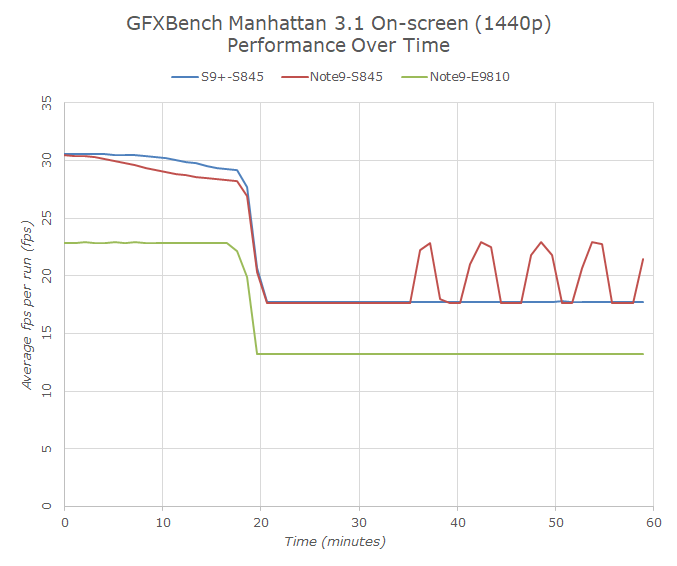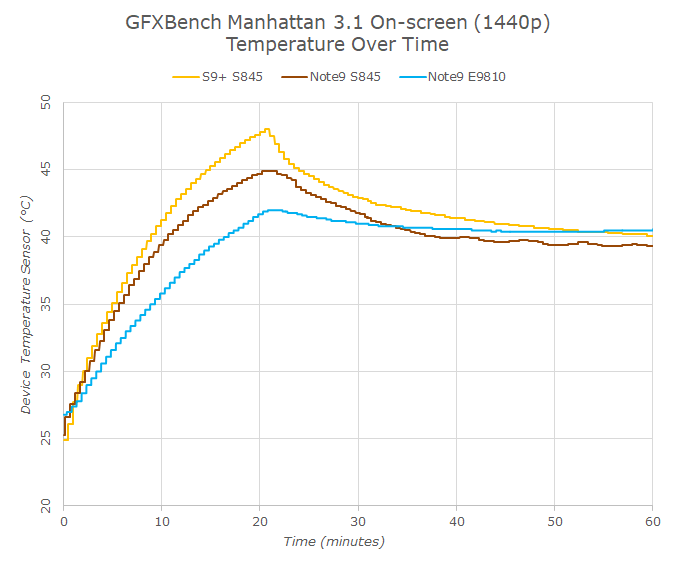Samsung Galaxy Note9 Performance & Battery Showdown: Snapdragon vs Exynos
by Andrei Frumusanu on November 26, 2018 8:00 AM ESTGPU Performance & Device Thermals
GPU performance of the Note9 shouldn’t be much of a surprise by now as we’ve covered the Snapdragon 845 and Exynos 9810 extensively in this regard. Yet, the Note9 does differ significantly in this regard because Samsung claims to have included a new massive heat-pipe and heat spreader, theoretically much improving the thermal dissipation from the SoC to the body of the phone.
I’m actually starting off this article with a test of the device’s thermals, because I found some quite weird results here that I feel are quite inexplicable in their behaviour, and something that I found to happen in quite a lot of the Snapdragon 845 devices in 2018.
I’m using the on-screen Manhattan 3.1 test in 1440p on-screen mode in a continuous loop for an hour. Besides both Note9’s, I’m also including the S9+ in order to see just how much of an effect the Note9’s new heat-pipe is able to help with performance and thermals.
Performance wise, the results are very surprising. The Snapdragon Note9 for the better part of the first 20 minutes seems to actually perform slightly worse than the S9+. Both phones look to be throttling at virtually the same identical point, which I also found to be quite weird. It’s only much later in the test, after the 35 minute mark, where the Note9 starts to fluctuate more in terms of performance, recovering to a higher GPU frequency for a few minutes before falling back to the minimum performance and continuing so forth ad infinitum.
The Exynos Note9 as expected, performs worse than the Snapdragon unit, but this shouldn’t be much of a surprise.
Actually examining the temperature reported by the phones we again see some very weird behaviour. The temperature here is as reported by an internal sensor on the phones. I don’t usually like showcasing these results because the sensors will vary between devices and vendors. This case is an exception because the sensor between the two Note9’s should be identical (battery PMIC IC), as well as very comparable to the S9+. The actual maximum skin temperature as measured by an IR thermometer are higher than the values shown here.
The one thing that again feels utterly unexplainable to me is the fact that there’s a notable change in throttling behaviour after the 20 minute mark, all seemingly unrelated to the actual temperature of the phones. The Snapdragon Note9 does report much better maximum temperatures over the S9+. The Exynos Note9 here also achieves even better temperatures, and this pretty much falls in line with the fact that the Exynos 9810’s peak power consumption in GPU workloads is actually lower than the Snapdragon 845’s.
Now this 20 minute mark in the temperatures is something that I’ve encountered more often this year across devices, yet I haven’t actually found any good evidence as to explain it. The Snapdragon Note9 showcases that it has intermediate throttling levels later on in its runtime, what puzzles me is as to why the device doesn’t set this medium frequency level earlier in the runtime when reaching the same throttling temperature?
The Snapdragon 845’s behaviour here is very weird: In our initial review of the Galaxy S9+ I mentioned that the phone entered an overheating state killing the benchmark, reaching high skin temperatures of up to 58°C. In subsequent firmware updates over the summer I wasn't able to reproduce this anymore. I actually found the same issue in the Xiaomi Mi MIX2S which was also quickly resolved with a firmware update. This lets me believe that Qualcomm actually has some sort of time-, rather than a temperature-based boost/throttle mode in the drivers of the chip. I’m very perplexed by this as I can’t discern if this is a legitimate mechanism or not.
The benchmarks
The thermal considerations being mentioned, we continue on with our standard set of benchmarks.

In the 3DMark Physics test, the Note 9 fares extremely well in terms of the sustained performance scores. Here we see quite a jump over the results of the S9+, and at the same time this makes the Snapdragon Note9 the best S845 device in this particular benchmark.
The Exynos Note9 also showcases much improved sustained performance scores much higher than that of the S9.

The 3DMark graphics results have me a bit perplexed. The Snapdragon Note9’s sustained performance scores are good- really good- too good.
We showcased that the devices do throttle after certain amount of time, yet in 3DMark I wasn’t able to actually enter this sustained state in any way on the Note9’s, even after prolonged heating. I don’t have a way to loop 3DMark in the same way I loop GFXBench, and I have to wonder if this plays a role here. The Snapdragon Note9 was allowed to get really hot here, reaching 48°C+ skin temperatures near the SoC.
I’m using obfuscated applications IDs to avoid benchmark detection – still I have some reservations about these scores on whether they’re results of genuine thermal mechanisms or something else.


Moving on to GFXBench, we’re seeing some more reasonable sustained performance results in the “High” benchmark mode. Again I have a hard time explaining why the Normal mode scores that much better for the Snapdragon Note9, here it’s maybe a side-effect of the higher ALU utilisation in the high mode which also causes higher power consumption in the Adreno 630.

In Manhattan, we see a similar result as in the Normal Aztec run, with the Snapdragon 845 Note9 maintaining excellent sustained perf.

Switching over to T-Rex, things again are more in line with previous Snapdragon 845 results. The Exynos Note9 also is behaving very similar to the S9.
I’ve ran these tests several times now and again noticed there some unexplained variability in the results that aren’t explained by the actual temperature of the phones. Under thermal stress, the Snapdragon Note9 sometimes performs excellently even at high sustained temperatures of the device, and sometimes it logically throttles as you would expect it to. It’s something I’ll have to dig in a bit more into.
In any case, the verdict here is that the Snapdragon Note9 performs excellently in terms of sustained performance. The Exynos Note9’s sustained performance in GFXBench was a lot more alike the S9 – both devices allowing for much lesser peak temperatures than the Snapdragon counterparts, but again both also showcasing significantly worse performance due to the weaker GPUs.












69 Comments
View All Comments
cha0z_ - Wednesday, November 28, 2018 - link
When note 9 was in preorder, all the reviews were the snapdragon 845 variant, draw the conclusions for yourself, but for me it's obvious what samsung did. :)Tams80 - Monday, December 3, 2018 - link
You might have a case with the consumer ombudsman.The UK also has class action lawsuits, but as it's still relatively new to the UK, it'll probably be even more troublesome.
Sjokoprins - Wednesday, November 28, 2018 - link
If there's a new apple device then there would be a very thorough in depth review, as for a new samsung flagship: they do not mind it seems.And that is really apple biased.
The know very well at anandtech how to avoid exposure to samsung phones and how to generate a lot of attention to apple phones......
Meteor2 - Monday, November 26, 2018 - link
I would think the 20-minute limit on max GPU performance is because that’s the typical maximum length of time people play games on mobile phones for. The designers are letting temperatures reach battery-damaging levels to secure performance — but only briefly.jaju123 - Monday, November 26, 2018 - link
When you read this and realise you just ordered the 512gb Exynos Note 9. :OAre there custom kernels out there that somewhat mitigate these issues?
lmcd - Monday, November 26, 2018 - link
The "issues" are bad custom CPU core designs out of Samsung. Kernels don't solve that.It's not "fall on its face" horrible, Samsung's cores still wipe the floor with A53s and A55s. Just not flagship level.
multicorn - Tuesday, November 27, 2018 - link
There are no issues. I have the 128 GB Exynos Note 9. It's absolutely perfect. So, e.g. when I go to bed, I usually have 50% of battery left. Maybe with the QC model I would have 55%. Do I care? Nope. Same with performance. Everything works flawlessly. Maybe the QC model scores higher in benchmarks, so what? In real world usage you won't notice any difference. Would I notice the difference between the Exynos models DAC vs. the inferior DAC in the QC model? Maybe..Spunjji - Tuesday, November 27, 2018 - link
As someone who's owned a few generations of Exynos Samsung devices, I'd warn you away from messing with custom kernels. They tend to be flaky, unreliably supported and more hassle to implement than they're worth in terms of performance. Try out the device, see if the performance suits you and buy accordingly. You won't get the full set of Note 9 features from anyone else so it should really be about what you want from the phone rather than its absolute performance (within acceptable boundaries).cha0z_ - Wednesday, November 28, 2018 - link
Not really, only one kernel and it's not that active in development. That part of the forums is so dead that I can't believe it... and this for the best phone samsung offers currently. Can understand the devs tho, why buy, keep and spend time on device with such a massive failure of a SOC. The phone is good in real world usage tho, I have one, but everyone who tested both exynos and sd variants said that the difference is a lot bigger than they was prepared to be and kept the sd. :)Quantumz0d - Monday, November 26, 2018 - link
Excellent piece Andrei, thanks.Especially the battery part and fuel gauge. Please kindly do mention the workings of them. Very much interested in this aspect especially how the iPhone does and their "manual throttle switch". I read your post on how Samsung caps the battery charging to keep more lifetime, on XDA, this confuses me about the battery longevity discrepancy that you mentioned. To add my OP3 fuel gauge chip also blocks installing the 3Ts higher spec battery (3000 vs 3300) and voltages, though a developer managed to get the reading of cycles from it (Sultanxda) and the mentioning of the GPU and thermals is really fantastic coverage, I believe the S.LSI and Samsung Mobile have bureaucracy issues like Intel and lost their direction, just like how LG is doing badly with marketing and their drastic change after Exec shakeup after failed Quarter results. Its unfortunate that they dropped their unique design with V40 and G7, even the marketing is bad and going mainstream like camera game on their site " 5 cameras". Your point is definitely valid with Huawei execution but that phone is against user control with EMUI and rollback bricks and BL unlock and total copypasta design.
I wanted to import a Note 9 but the ebay and price where I wanted to import are too expensive. And the LTE bands issues with carrier aggregation in US LTE Network. And the 9810 issues with perf and battery issues, though the Custom ROM scene is excellent with Exynos devices, Note 9.
I picked up a V30S instead for 500 bucks, US warranty and has fairly good battery life and underrated specs it has Qnovo Adaptive charging technology which saves the battery from over doing its cycles and reduce the fatigue. Maybe you can look at them, Sony also does this Qnovo technology.